.:HSTuners::::Hondas Wanted:: |
|
|
#1 |
|
Super Moderator
Join Date: Sep 2001
Location: Kentucky
Age: 43
Posts: 1,427
|
Potential of SOHC D16 All Motor
Expert Advice Needed
What can I expect if I decided to go all motor on my D16 monster. Whats the HP and Tq that I can expect to get out of it. Thanks
__________________
2008 Mustang GT 1998 Hatchback SOLD 1992 Hatchback w/ JDM H22A SOLD 1985 Ford Bronco XLT 5.8 351W w/ 33X12.5X15 |
|
|

|
|
|
#2 |
|
Posts: n/a
|
D Series Engine Building Tips
Building D series and ZC Honda engines is a pretty straight forward task. As with any engine build-up, all clearances must be worked out well in advance of the final assembly process, enabling the assembly to take place like a model kit. A clean assembly environment is also essential for a successful build-up. I recommend doing assembly in a closed area (not outside), where there's little or no dust. If it's in a garage, I recommend hosing down the floor and anything else necessary to keep airborne particles to a minimum. An engine stand is certainly a help when it's time to install pistons and another pair of hands doesn't hurt either. Keep a couple large rolls of Bounty paper towels on hand and use them instead of rags for wiping and cleaning. The first picture series is some pretty basic stuff that makes sense. The mods are configured to improve the efficiency of the oil pump. While there are several internal tricks, we're showing some things here that are easy to do and they won't ruin the pump, if you're a little bit off with the grinder. 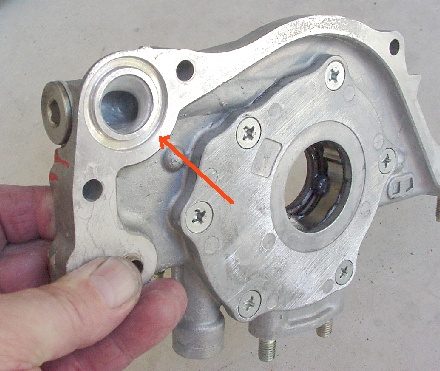 Note that the oil exit in the pump has been radiused into the passage and it's also been flared to match the oil gallery diameter in the block. While it's not visible here, we fill the area behind the allen plug at the end of the pump's exit passage to smooth the flared turn's back wall. A good aluminum based epoxy will work fine for the job. Make sure that you disassemble the pump prior to doing these mods, so there's no grinding material left inside. 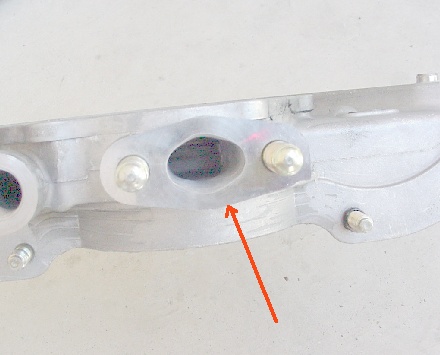 While it's difficult to see in this photo, we smooth the entry passage into the pump and carefully radius the transition into the actual pump housing to increase area and improve oil flow. We also make sure the pick-up tube is matched correctly to the pump, with no sharp lips to disturb the flow. Block notching seems to be another thing that many builders are unsure of. It's an easy process and here are a few tips on how-to-do it properly. 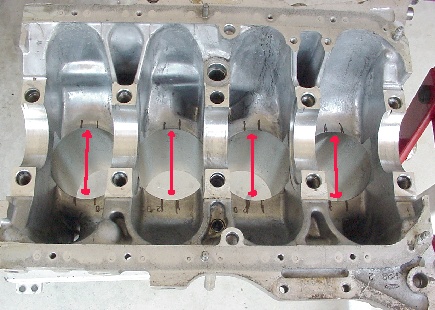 We mark an area that's 3/4" wide and approximately centered on each side of the block's cylinder bores. 3/4" is plenty of distance to clear the rods' beams ans we'll taper the cut from outside the lines back to the cylinder bores. If you put a mark that's 1/4" into the block and 1/4" down into the bores, that's the amount you'll be removing...effectively straight-lining the area with your grinder. 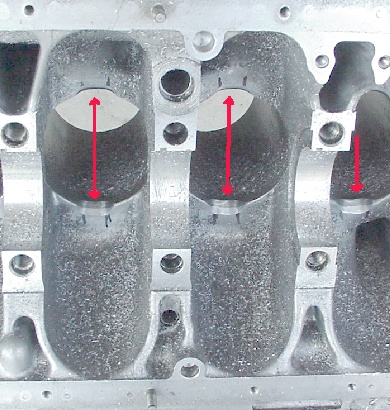 This photo shows the block after about 10 minutes with a die grinder and a carbide cutter. Notice how the corners of the reliefs are tapered back to the original lower edge of the cylinder. You do not want square edges in these areas, as stress risers could develop. make sure when you're grinding in these areas on the block that you wear eye protection, as the cast iron particles from the cylinder liner will rust in your eyes and having them "drilled" out, isn't a pleasant experience. Obviously, the block will need to be cleaned after this operation, as is evidenced by the grinding debris in the photo.  |

|
|
|
#3 |
|
Posts: n/a
|
CONTINUED
Here's the finished product. The reliefs have been just "touched" by a 60 grit cartridge roll and a tiny radius has also been placed on the bottom of the cylinder bore. This will make the transition back up the cylinder wall a little less "wearing" for the pistons' skirts. The block has been thoroughly cleaned with a solvent and then it's been scrubbed with hot soapy water, prior to the final rinse with hot water. Blow the block dry, including all the bolt holes. Make a good sized roll of Bounty towels on some sticks (paint stirrers work great), spray them with some WD-40 and wipe the cylinder bores until there's no hint of dirt, or surface rust showing. 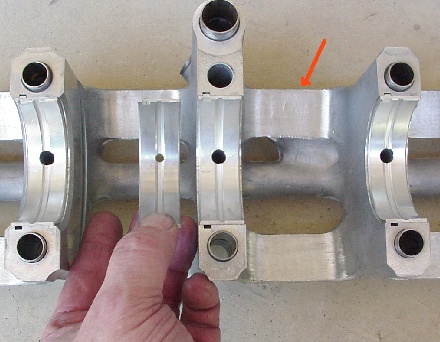 I catch a lot of flack about the size I open the oil holes in the bearings out to. Those who don't care for the practice, have never apparently experienced oiling problems, or they've never made enough power to be concerned. We open the oil holes in the bearings, after fitting the bearings to the block/crank with micrometers / dial-bore gauges and finally Plasti-Gage.) The holes are in perfect alignment with the feed holes in the main caps...and oddly enough, they're darned near the same diameter as the oil holes in the crankshaft. Who'd have thought? Also of note, we grind the edges of the girdle to remove any radius. That might sound strange, but sharp edges will "shave" oil off the rotating crankshaft and rod assembly with considerable efficiency and that's very desirable for a performance engine. It's also free, if you have a little time to spend.  Do yourself and the piston rings a favor and use a scissors-band-style ring compressor for piston/rod installation. Most of the cheapie ring compressors are good at damaging, or breaking rings and you won't find out until the engines in the car, running, and smoking. 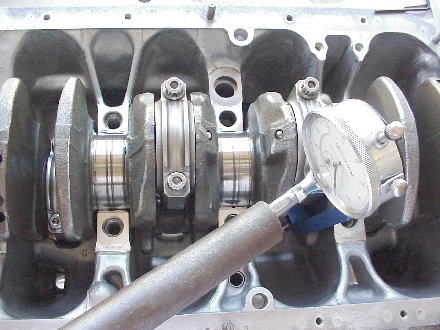 While they aren't visible in this picture, we use a couple main caps that we've cut from an old D16 girdle at the #1 and #5 main to hold the crankshaft in while we're torquing the rod caps. The D series girdle leaves little room for the rod bolt stretch gauge and this is one area where correctly stretched bolts are important. I also use a steel tube placed on the end of the 3/8" 12 point wrench to permit me to "pull" the bolt to the correct length in one smooth motion. We usually torque the bolts to 15 foot pounds, to seat the rod cap and follow up by loosening them to about 5 foot pounds and stretching them to the instructed dimension with the gauge. 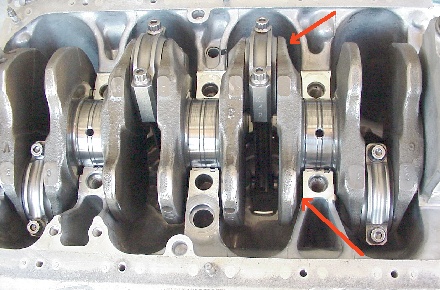 It's not terribly visible in this picture, but you can see that we've "cleaned-up" this crank's surfaces considerably. In addition to X-Raying the crank and looking for surface flaws, the crank's oil holes have all been carefully chamfered and all the balancing was accomplished by radiusing material off the counter weights and throws, rather than drilling more holes. The crank has also been thoroughly stress relieved, as the application is one placing it under considerable "pressure." I should also note that this engine isn't configured to rev past 7,500 rpm, so extensive crank lightening wasn't part of the plan, as it would be for a normally aspirated engine. This about sums up the tips for the D series bottom ends. We didn't show it, but we do open the diameter of the main oil gallery on the side of the block and we also do considerable radiusing of it's intersect with the oil filter housing. Make sure that you clean the threads in all the bolt holes that perform critical tasks. Use either new bolts, or studs where available. I also recommend using some high pressure engine building graphite-moly on the threads, prior to torquing and don't forget to lube the washers as well. Please send all comments to the staff address and we'll attempt to make the next article the way you guys request. Borrowed from Endyn... 10 Second D16 Motor i believe? |

|
|
|
#4 |
|
Super Moderator
Join Date: Sep 2001
Location: Kentucky
Age: 43
Posts: 1,427
|
Thanks for the great info. The explanation is phenominal. I think I spelled it right. Either way thanks for the explanation.
__________________
2008 Mustang GT 1998 Hatchback SOLD 1992 Hatchback w/ JDM H22A SOLD 1985 Ford Bronco XLT 5.8 351W w/ 33X12.5X15 |
|
|

|
|
|
#5 |
|
Posts: n/a
|
Hah i doubt u even read all of that
 It was too long for me! It was too long for me! |

|
|
|
#6 |
|
Posts: n/a
|
I won't lie VnTec. I find it very interesting and i do plan to read it but i didn't. Hehe. HOnesty is the best policy.
|

|
|
|
#7 |
|
Posts: n/a
|
Hey VNTEch why don't u put that in the how to do section or in the sticky?
|

|
|
|
#8 |
|
Posts: n/a
|
course one thing is that there was no mention of compression ratios or head work. If you're planning on building N/A SOHC I would reccomend using a higher compression piston and making sure the tolerance is very close. You have to be careful not to ram the valves into the pistons as that would be well...bad. I'm sure you know that already but I just put that there for those who don't. Also you may want to consider utilizing a bigger lobed cam and better head package. I have seen as much as 50 hp gained from just cams and proper tuning. I've been toying with the idea of building a 1.5 SOHC motor for a bit and have been doing some research, I think the largest compression piston that I can get to work is about 12:1 which is crazy. I did find that GUDE makes a head package that will perform to what I would need but on the same note Crower will regrind cams (as ALL their cams are regrinds) to my specs. Any how that's enough outta me for now.
|

|
|
|
#9 |
|
Posts: n/a
|
A great site to go to is www.theoldone.com He drives one of the fastest SuperCharged D16's out there..
|

|
|
|
#10 |
|
Posts: n/a
|
All of Crowers cams are not regrinds. You can specify a regrind if you like but it not recommended. I have 3 sets of Crower cams and they are not regrinds.
|

|
|
|
#11 |
|
4th Gear
Join Date: Aug 2001
Location: Boulder, CO
Age: 44
Posts: 830
|
For the money it would take to do even a moderate D16 build, you could get a B16 swapped in, and make more power.
If you still decide a D16 build is the way to go, it depends on which direction you want to go. The Gude/Bullfrog head packages are a good way to go for a "moderate" build. The D16 package includes a p/p, upgraded valvetrain, aggressive cam and more. Expect up to 50 hp with good tuning. For a serious all motor build on a D16, go with Jun, and accept no substitutes. Also expect to spend twice as much. With either of these options, I would seriously recommend also building your bottom end with new rods and high compression pistons (both from Endyn). For the Bullfrog/Gude, I would also recommend a blockguard. For the Jun, you should consider cylinder sleeving, a built crank, and upgrading your head studs. As for the article from TOO: While it's very informative, I don't know of very many people adequately equipped (with the tools or the talent) to be doing that in their garage. It's a great article, but I feel it would be a little out of place in the how-to forum amongst header installs and removing your stock resonator. |
|
|

|
 |
| Thread Tools | |
| Display Modes | |
|
|